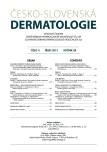Rare Form of Tinea capitis Profunda Caused by Trichophyton tonsurans in Child
Authors:
T. Danilla
Authors‘ workplace:
Detská dermatovenerologická klinika LFUK a DFNsP, Bratislava
prednosta doc. MUDr. Tibor Danilla, CSc.
Published in:
Čes-slov Derm, 88, 2013, No. 4, p. 178-180
Category:
Case Reports
Overview
Tinea capitis profunda caused by Trichophyton tonsurans is rare, especially in children. The author describes the clinical manifestations, epidemiological investigation, diagnosis and treatment of this disease in a child aged four and half years. Attention is drawn to the diagnostic and therapeutic problems in outpatient practice and the risk of infection spreading in a population.
Key words:
Tinea capitis profunda – Trichophytia profunda capillitii – Trichophyton tonsurans – child
Sources
1. BINDER, B., LACKNER, H. K., POESSL, B. D. et al. Prevalence of tinea capitis in Southeastern Austria between 1985 and 2008: up-to-date Picture of the current situation. Mycoses, 2011, 54, 3, p. 243–247.
2. BLAŽOVSKY, J. Trichophytia superficialis u súrodencov vyvolaná hubou Trichophyton tonsurans Malmsten, 1845 var. sulfureum. Čes.-slov. Derm., 1988, 63, 3, s. 156–161.
3. BRASCH, J. Bewährte und neue Verfahren zur Differenzierung von Dermatophyten. Hautarzt, 2004, 22, 3, p. 136–142.
4. BUCHVALD, J. Historický prehľad dermatomykológie na Slovensku s prihliadnutím k epidemiologickej situácii výskytu dermatomykóz na slovenskom území. Čes.-slov. Derm., 1965, 40, 2, s. 65–80.
5. DANILLA, T. Hubové choroby kože – diagnostický a liečebný problém u detí. Lek. Obz., 2012, 61, 1, s. 27–31.
6. DANILLA, T. Nie všetko je ekzém II. Pediatria pre prax, 2012, 13, 1, s. 14–15.
7. DOLENC-VOLJČ, M. Dermatophyte infections in the Ljubjana region, Slovenia, 1995–2002. Mycoses, 2005, 48, 3, p. 181–186.
8. ELEWSKI, B. E. Cutaneous mycoses in children. B. J. Dermatol., 1996, 134, suppl. 46, p. 7–11.
9. ELLIS, D., DAVIS, S., ALEXIOU, H., HANDKE, R., BARTLEY, R. Description of Medical Fungi. Adelaide: Nexus Print Solutions, 2007, s. 198, ISBN 9780959851267.
10. GILABERTE, Y., REZUSTA, A., GIL, J. et al. Tinea capitis in infants in their first year of live. B. J. Dermatol., 2004, 151, 4, p. 886–890.
11. GINTER-HANSELMAYER, G., WEGER, W., ILKIT, M., SMOLLE, J. Epidemiology of tinea capitis in Europe: current state and changing patterns. Mycoses, 2007, 50, suppl. 2, p. 6–13.
12. GUPTA, A. K., SUMMERBELL, R. C. Tinea capitis. Med. Myco, 2000, 38, 4, p. 255–287.
13. HACKETT, B. C., OęCONNELL, K., CAFFERKEY, M., OęDONNELL, B. F., KEANE, F. M. Tinea capitis in paediatric population. Ir. Med. J., 2006, 99, 10, p. 294–295.
14. HAY, R. J., ROBLES, W., MIDGLEY, G., MOORE, M. K. Tinea capitis in Europe: new perspective on an old problem. J. Eur. Acad. Dermatol. Venereol., 2001, 15, 3, p. 229–233.
15. KREMPL-LAMPLECHT, I., BARFUS, T., METZ, J. Isolierung von Trichophyton tonsurans Malmsten (var. sulfureum und cerebriforme) und trichophyton verrucosum Bodin bei Kerion Celsi. Mykosen, 1981, 25, p. 383–385.
16. VOLLEKOVÁ, A., TÓTHOVÁ, I., BAROŇÁKOVÁ, A., KOLIBÁŠOVÁ, K., LENGYELOVÁ, J. Prvá epidémia povrchovej trichofýcie Trichophyton tonsurans medzi zápasníkmi na území Slovenska. Čes.-slov. Derm., 1997, 72, 1, p. 3–7.
17. VOLLEKOVÁ, A., DANILLA, T. Pohľad na epidémie trichofýcií Trichophyton tonsurans medzi zápasníkmi (1994–1996). Epidemiol. Microbiol. Imunol., 1999, 48, 1, s. 16–20.
Labels
Dermatology & STDs Paediatric dermatology & STDsArticle was published in
Czech-Slovak Dermatology

2013 Issue 4
Most read in this issue
- Nail surgery: Introduction, Review on Surgical Techniques and Our Experience in Selected Nail Diseases
- Dermatosurgery and its Crucial Position in the Field of Dermatology and Venereology
- Rare Form of Tinea capitis Profunda Caused by Trichophyton tonsurans in Child
- UVA1 in the Management of Dermatoses
